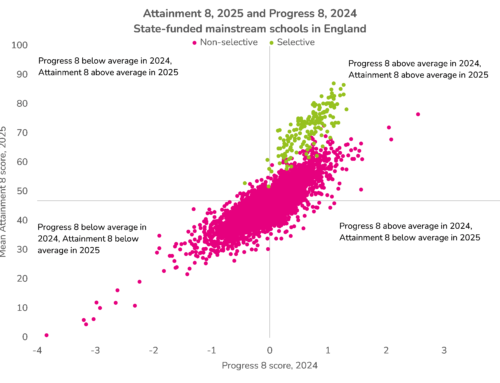
Our Who’s Left work has led us to conclude that a group of 6,700-9,200 pupils from the 2018 GCSE cohort did not take any qualifications or, if they did, did not count in the results of any establishment. This is of great concern.
It has led us to believe that a number of things need to be done to improve things for pupils, both in terms of educational attainment and other areas such as safeguarding.
These are eight things that the Department for Education needs to do urgently. While action is needed in a number of other areas, we’ve limited ourselves to the areas we know most about, namely school accountability and record-keeping.
1. Reweight secondary school league tables to take all pupils into account, in proportion to the amount of time that they spend on roll.
A pupil who completes 80% of their secondary education at a school before leaving should count with 80% of the weight of a pupil who completes their entire secondary education there, for example.
Why?
Currently, in most circumstances, pupils who have left the roll of a school before January of Year 11 don’t count towards that school’s results. As such, for the minority of number of schools that would be motivated to do this, a pupil who is likely to bring down a school’s results can be removed from its roll – either through a formal exclusion, or through off-rolling.
If schools retained partial accountability for pupils who left their rolls then there would be less incentive to lose pupils likely to bring a school’s results down – as the pupil would still count, say, 80% towards their results. For those pupils who did leave the roll, the school would have a greater interest in ensuring that they left to a destination which was going to serve the pupil well.[1]
At the same time, schools would have a greater incentive to accept pupils at non-standard entry points, as the impact of these pupils on results would not be as great as it is at present.
In order to implement this proposal, it is likely that schools would need to be given responsibility for commissioning alternative provision places for pupils who did leave their roll, similar to a proposal accepted in the government’s response to the Timpson report on exclusions.
'Reweight secondary school league tables to take *all* pupils into account, in proportion to the amount of time that they spend on roll' - one of the recommendations from @FFTEduDatalab’s work on the pupils leaving mainstream schools Tweet this2. Go ahead with the register of pupils being home educated that was proposed by the government earlier this year, and publish national statistics based on this.
Why?
Currently, only estimates are available on the number of pupils being educated at home, produced by the Association of Directors of Children’s Services and the Schools Adjudicator. These suggest that there may be something of the order of 60,000 pupils being home educated at a given point in time.
All evidence suggests that the number of pupils being educated at home has increased greatly in recent years. The government itself accepts that this is a symptom of problems in the school system rather than being driven by a change in philosophical beliefs.
“However, the government does not believe that the significant increase in children deemed to be educated at home which has taken place in recent years … has arisen from any significant growth in those who believe in the virtues of home education for its own sake. Rather, it believes that the factors leading to a significant proportion of the children now receiving education at home are more negative.”
Government response to call for evidence on elective home education, April 2019
3. Collect and publish school-level figures on the number of pupils withdrawn for home education.
Why?
School-level figures are already published on exclusions. As set out above, much of the rise in home education numbers is attributed to factors other than parental philosophy. Publishing these figures would allow for stronger local accountability.
'Collect and publish school-level figures on the number of pupils withdrawn for home education' - one of the recommendations from @FFTEduDatalab’s work on the pupils leaving mainstream schools Tweet this4. Require alternative provision that is currently unregistered to be registered with the DfE as a condition of schools, local authorities and academy trusts being able to use of it.
Why?
The DfE does not know how many pupils are receiving education in unregistered alternative provision, nor the total number of such providers.
Lucy Powell MP: To ask the Secretary of State for Education, what recent estimate he has made of the number of children receiving unregistered alternative education provision.
Nick Gibb MP: The information is not held centrally.
Data on alternative provision (AP) is collected by the Department in two ways. The school census collects details of those pupils in pupil referral units, AP academies and AP free schools. This provision is commissioned by local authorities and includes pupils who may be dual-registered with an AP provider and a mainstream school. The school census is a statutory requirement and is collected three times a year (termly, in October, January and May).
The AP census collects details on pupil placements in AP settings where a local authority is paying full tuition fees. This includes independent schools, further education colleges offering pre-16 provision and unregistered settings.
However, neither the school census nor the AP census collect details on pupils placed in unregistered settings funded directly by schools.
Recent work of ours put the number of pupils in unregistered provision at up to 2,600. In the absence of an official record of providers there is no way to fully judge the size of this part of the education landscape, nor tell whether it is changing in size.
We leave the question of what form exactly this registration would take for others.
5. Record independent alternative provision as its own category of institution in government data.
Why?
Independent alternative provision is one of the destinations to which pupils who leave mainstream education go. This can be in cases where state alternative provision is at capacity, or where the provision is considered more suitable for a particular pupil.
Despite this, we have no official figures on the size of this sector, nor the number of pupils educated here. This is because independent alternative provision is simply recorded in government datasets as an independent school, alongside mainstream independent schools.
Work that we carried out in 2018 with The Difference estimated that there were around 2,750 pupils on-roll at 112 independent alternative provision settings offering provision for secondary-age pupils. The work also found that there was a high number of openings and closures of such establishments, and that inspection ratings for these establishments were some way below those of state alternative provision.
Until independent alternative provision is recorded as an individual category of institution in government there will be a lack of clarity and accountability over this particular destination.
6. Record all those pupils receiving some of their education elsewhere – i.e. in independent or unregistered AP – in the termly school census.
Why?
Where pupils are receiving part of their education in a state AP setting they are recorded as such in the termly school census. This is not the case with independent or unregistered AP, meaning no information is available on mainstream schools’ use of these types of setting.
7. Record the reason why pupils have left the roll of a school in the termly school census.
Why?
Where a pupil leaves the roll of a school they are required to report the reason for this to the local authority – although there are varying levels of compliance with this requirement. Including this information in school census returns would significantly increase our understanding of the reasons why pupils leave mainstream school rolls, and the destinations to which they go.
'Record the reason why pupils have left the roll of a school in the termly school census' - one of the recommendations from @FFTEduDatalab’s work on the pupils leaving mainstream schools Tweet this8. Collect information on managed moves and publish national statistics on this, including on the type of establishment to which the pupil leaves in successful managed moves.
Why?
No figures are currently available on the number of managed moves that take place each year. Publishing these figures would help fill a gap in what we know about pupil movements – particularly in the case of managed moves into alternative provision.
Want to stay up-to-date with the latest research from FFT Education Datalab? Sign up to Datalab’s mailing list to get notifications about new blogposts, or to receive the team’s half-termly newsletter.
1. Others have proposed variations on this idea. The Headteachers’ Roundtable have talked about greater weight being given to pupils who started at a school in Year 7.









Every Local Authority should be required to regularly inspect the pupil registers of all legally registered schools, LA, Academies, Free Schools and private schools in their area and so track the educational arrangements of every child up to the age of 16. This should be integrated with the home schooling register.
How otherwise can children be protected from all manner of abuses including being taken out of the country for forced marriages and FGM?
Yes- along with the powers and funding to do so.
Might it be an idea to publish an analysis of the down side of each of the ideas above?
E.g. a school teaches a child well. They move in year 11. The next school’s options don’t fit the child. His or her results fall resultantly. Yet, the original school is penalised at an 80% level for something entirely beyond its control?
More pros and cons, less assertiveness over an untested idea?
Frying pan to fire comes to mind.
Hi Jim. Oh sure, there are pros and cons to everything. But we think that the pros of the reweighting approach far exceed the cons. In your example is it fair that the new school is fully accountable for the attainment of a pupil who joins them halfway through KS4 (or even later) who may have been studying different specs/ subjects at their previous school? In any event, there’s always the option of publishing performance measures on both the existing (end of Year 11) and reweighted bases.